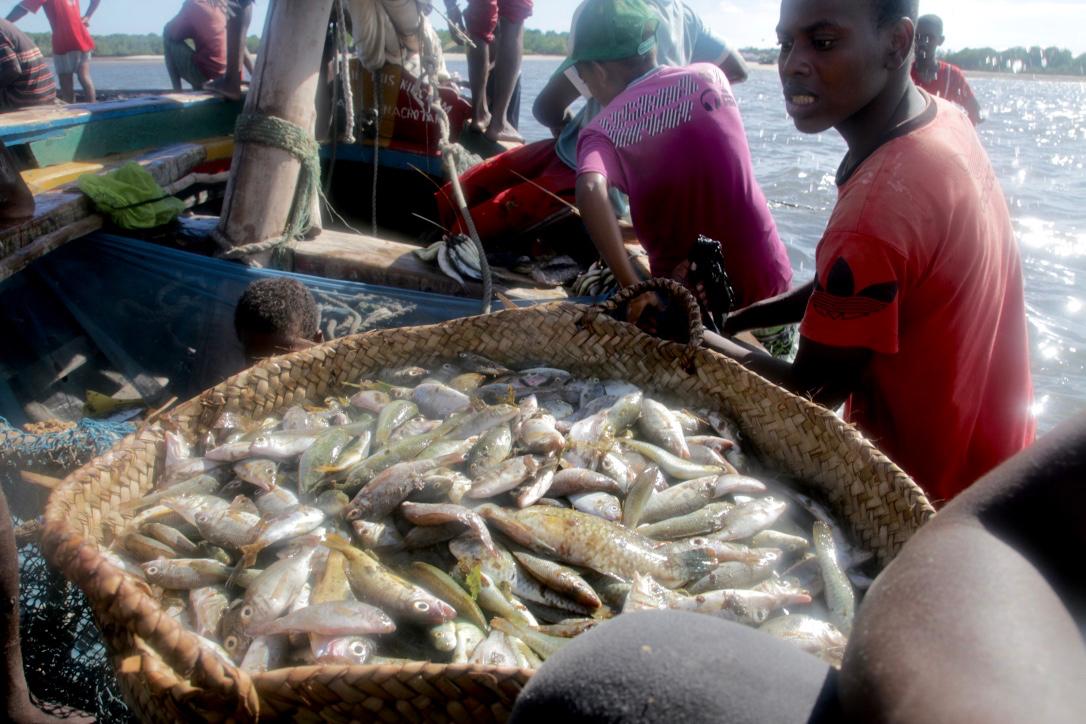New fishing nets bring big catches and protect Kenya’s Indian Ocean shores
Rules against old methods enforced to help juvenile fish, breeding areas, and corals

On a sunny afternoon at the Gasi beach landing site on Kenya’s Indian Ocean coast, Juma Said Mkuu scoops a handful of sardines in his hand.
“These were caught overnight,” he explains as a fisherman and fishmonger negotiate the price of the sardines.
Mr Mkuu is a fisherman and the chairperson of the Gasi Beach Management Unit, south of the city of Mombasa. He has been fishing for 20 years and explains the transformation in his lifestyle since he ditched using beach seine nets and embraced ring-nets, which came to Kenya from neighbouring Tanzania.
“The ring-net has transformed my life, I now own a permanent brick house and I am comfortably able to pay to take my children through high school,” Mr Mkuu says.
His story is synonymous with other fishermen at Gasi, which is a prominent fish trading centre. The ring-net fishing gear derives it name from metal rings fitted at the bottom of the net to help it sink when cast into the ocean. It first made its way into Kenyan waters in the early 1990s from nearby Tanzanian islands of Pemba and Zanzibar.
The net is fitted with several buoys at the sides to prevent it from fully sinking, and is operated by a crew of 15 to 40 fishermen on a mother boat and several support boats.
The net was quickly adopted by local of fishermen. They had been using illegal methods such as the beach seine net, spear guns, and dynamite, which involves setting off explosives on coral reefs to stun fish to the surface.
Artisanal fishing gear including beach seines, spear guns and gillnets caused the most damage to the corals that are food and habitat to about one third of marine fish species, according to a report published by the US National Centre of Biotechnology Information.
Local researchers found that 68 per cent of fish caught using beach seine nets, still being used illegally further north along Kenya's coastline at Lamu, were juvenile fish with approximately 6.5 percent of the catch being discarded due to being invaluable or inedible.
The experts also say spear guns damage coral reefs when they hit the corals, which they say can take more than 20 years to grow back.
However, the introduction of the nets was vehemently opposed by a section of fishermen in the region and this prompted Kenya's government initially to suspend their use between 2009 and 2010 as researchers and policy makers drafted laws to govern the use of the nets.
Cosmas Munga, a senior lecturer at the Technical University of Mombasa who has researched extensively on fishing gear, says the part of the reason why the gear was then legalised was to encourage fishermen to fish away from the shores to cut the risk of interfering with corals.
“Ring-nets target larger fish, 250 grams and above, and in most cases such species are pelagic meaning they are found in areas which are neither deep nor shallow,“ Dr Munga says. ”For a long time local fishermen have been using methods such as the spear gun and beach seine that have been attributed to the destruction of the coral and sea grass.“
Munga admits that if not properly used, the nets can cause destruction of the coral hence the reason why the government has been educating fishermen on effective use of the net as they await the passing of a set of laws drafted to govern use of the nets.
The draft laws state that among other laws the net should not be used in areas where the depth is less than 20 metres and areas which are less than three miles away from the shore.
However, even before the law is passed, local Beach Management Units are already enforcing the fishing rules to ensure that environmental conservation standards are upheld in their units.
“Before you are accepted as a member into our Beach Management Unit, you have to prove that you can adhere to the rules here, like avoiding fishing on shallow waters, that your mesh size is not less than 2.5 inches, and you should avoid setting your net in areas where you have spotted turtles and dolphins,” Mr Mkuu says
Where by-catch is trapped in the net, the beach management unit encourages the fishermen to release them back into the ocean when still alive, he added.
Statistics from the department of fisheries indicated that as of 2016, there were more than 70 ring-net gears being used along the Kenyan coast which has a capability of producing more than one million tonnes of fish annually.
In a bid to increase fishing productivity, the Kwale County government in 2016 rolled out a programme to distribute fishing vessels and ring-nets to beach management units.
According to the County Director of Fisheries, Martin Kiogora, the ambitious project is to help minimize the reliance on imported fish to meet local demand.
This article is reproduced here as part of the Giants Club African Conservation Journalism Fellowships, a programme of the charity Space for Giants and supported by the owner of ESI Media, which includes independent.co.uk. It aims to expand the reach of conservation and environmental journalism in Africa, and bring more African voices into the international conservation debate. Read the original story here


Join our commenting forum
Join thought-provoking conversations, follow other Independent readers and see their replies